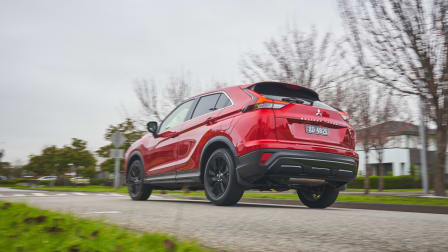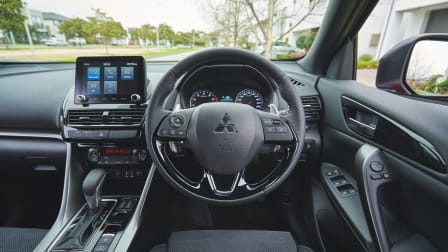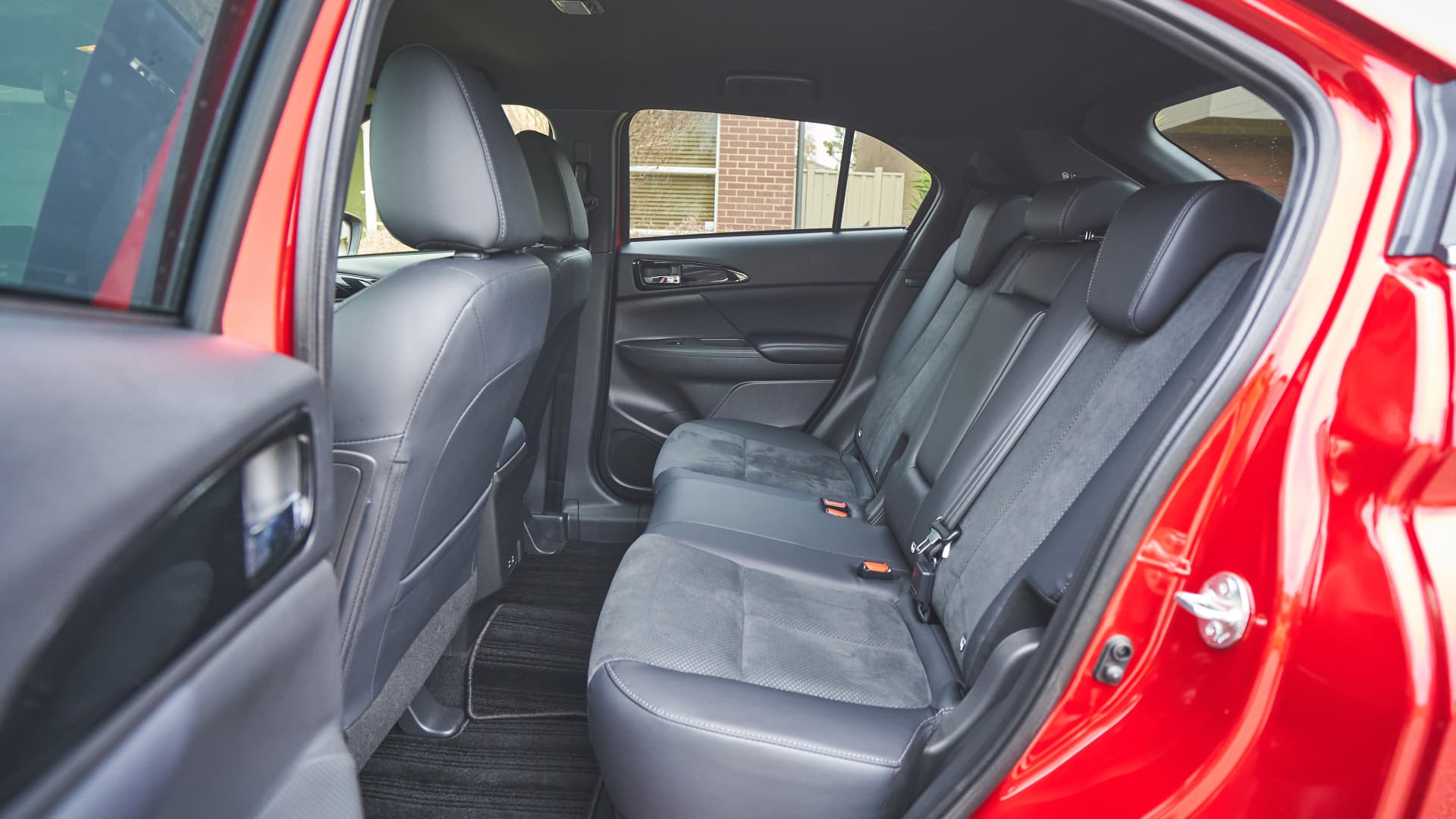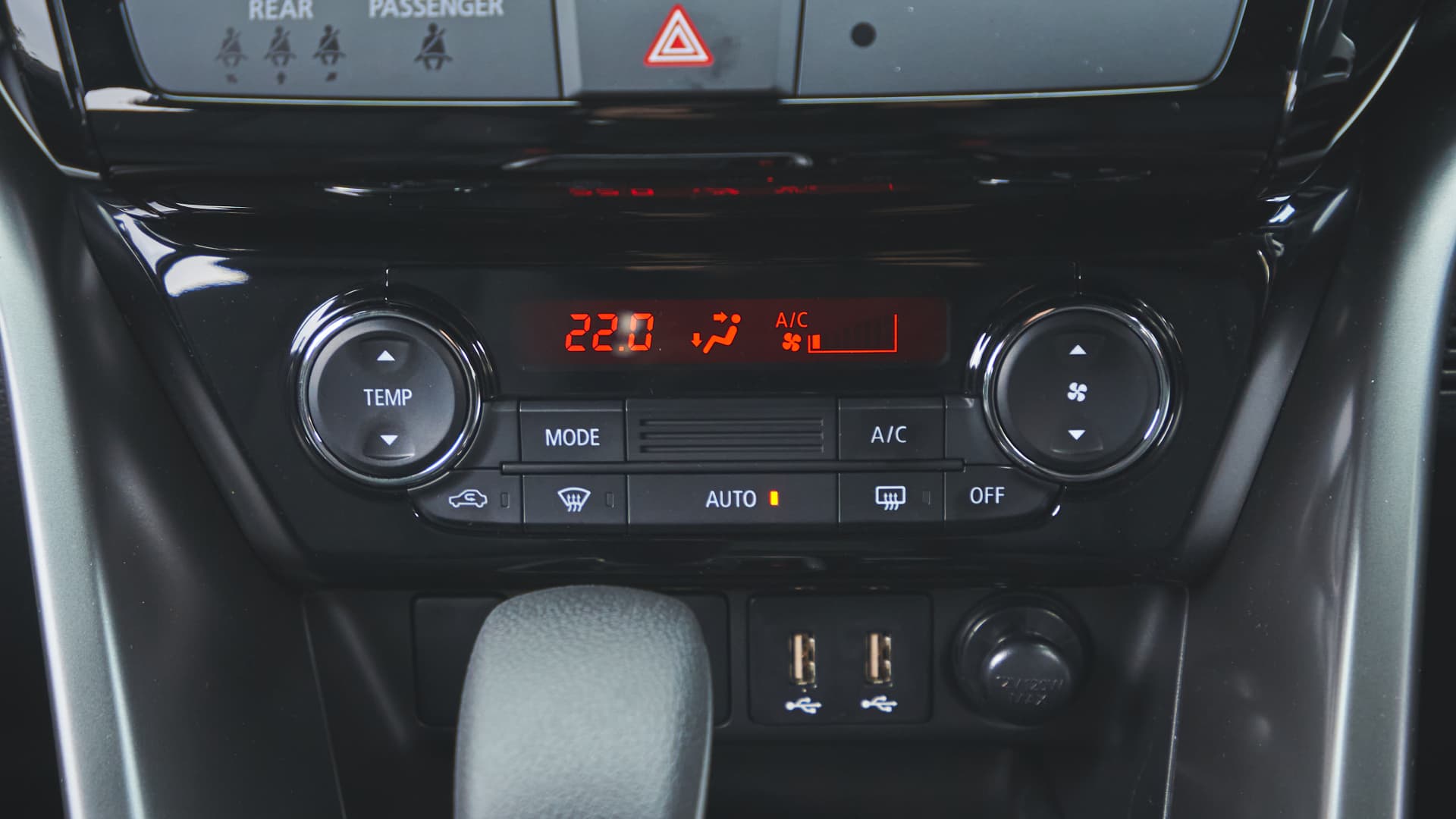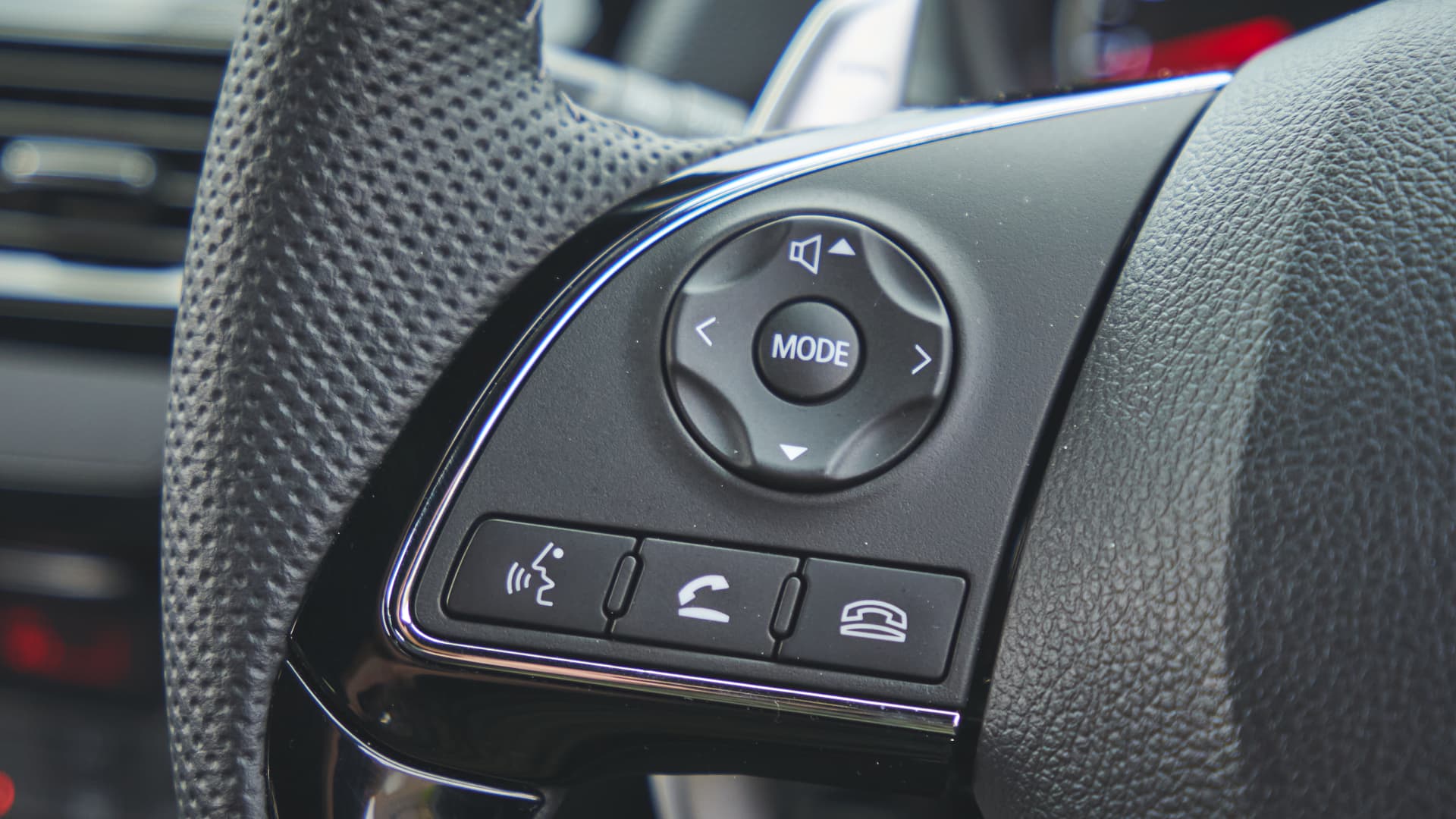- Doors and Seats
5 doors, 5 seats
- Engine
1.5T, 4 cyl.
- Engine Power
110kW, 250Nm
- Fuel
Petrol (91) 7.3L/100KM
- Manufacturer
FWD
- Transmission
Auto (CVT)
- Warranty
5 Yr, 100000 KMs
- Ancap Safety
5/5 star (2017)
2023 Mitsubishi Eclipse Cross Black Edition review
The Mitsubishi Eclipse Cross forms part of a one-two small SUV punch from the Japanese carmaker, but now that it's had a 'Black Edition' makeover, can the larger of the two stand out in a crowded market?
- Feels right at home as an urban commuter
- Useful interior space
- Simple and unobtrusive user interfaces
- Interior starting to look and feel dated
- No real dynamic flair
- Safety spec falls short of contemporary expectations
2023 Mitsubishi Eclipse Cross
Some trends seem to flit by quickly, like ice bucket challenges and flash mobs, but others like the gender reveal parties and automotive 'Black Editions' really seem to hang around. Whether they ought to or not.
For a little showroom push, Mitsubishi has applied the Black Edition treatment to models like the seven-seat Outlander medium SUV, and this, the Eclipse Cross small SUV.
It's a package primarily focussed on style – adding in (as the name suggests) black design features like the 18-inch alloy wheels, mirror caps, and gloss black lower cladding on the front and rear bumpers. The roof rails have also been removed for a cleaner look, and highlights like the window trim and sides of 'dynamic shield' grille retain chrome trim.
Inside the interior goes black-on-black too, with upgraded materials like microsuede and leather-look seat trim, black decor around the gear selector, and power adjustment for the driver's seat.
Beyond that, the Eclipse Cross Black Edition sticks closely to the specs and equipment provided in the Eclipse Cross LS on which it's based (more on that below).
How much does the Mitsubishi Eclipse Cross cost in Australia?
The Eclipse Cross petrol range kicks off from $31,490 plus on-road costs for the most basic ES version, stepping up to $34,240 and then $35,490 for the LS and LS Black edition respectively – all as two-wheel-drive models. Further up the model range there are Aspire and Exceed grades from $36,490 and $40,490.
In something of a spec-quirk, it's possible to get all-wheel-drive versions of the LS and Exceed for an additional $2500, but the ES, LS Black Edition, and Aspire are 2WD-only.
Plug-in hybrid models are also available in ES AWD ($47,290), Aspire AWD ($51,240), and Exceed AWD ($55,990) grades. All prices are before on-road costs.
That means the $35,490 asking price for the Eclipse Cross LS Black Edition driver here is a $1250 step up over the regular LS, and adds premium Red Diamond paint for an extra $200 (black and grey are no-cost options). That gives the car you see here a drive-away price of $40,090 in Melbourne, though final pricing may vary by state.
In the competitor pool, the Eclipse Cross faces off against Mitsubishi's own, slightly smaller ASX Exceed ($34,740 plus on-road costs), Subaru Crosstrek L ($34,990 plus on-road costs), Nissan Qashqai ST+ ($37,890 plus on-road costs), Kia Seltos Sport+ ($35,800 plus on-road costs), Mazda CX-30 G20 Evolve ($33,310 plus on-road costs) and Toyota Corolla Cross GXL ($37,730 plus on-road costs) among a mix of many other competitors that cross over the Black Edition's mid-$30K price point.
| Key details | 2023 Mitsubishi Eclipse Cross Black Edition |
| Price | $35,490 plus on-road costs |
| Colour of test car | Red Diamond |
| Options | Premium paint – $200 |
| Price as tested | $35,690 plus on-road costs |
| Drive-away price | $40,090 (Melbourne) |
| Rivals | Nissan Qashqai | Kia Seltos | Toyota Corolla Cross |
How much space does the Mitsubishi Eclipse Cross have inside?
If you weren't quite sure why Mitsubishi fields both the Eclipse Cross and ASX into the same Small SUV vehicle class, an exploration of the space inside is a tell-tale giveaway of what separates the two.
Of course, the Eclipse can't defy the constraints of its overall size, but from inside the Eclipse Cross offers little to grumble about in terms of passenger accommodation.
Get a great deal today
Interested in this car? Provide your details and we'll connect you to a member of the Drive team.
To start with, the driver's seat has quite a lofty position, giving a tall vantage point for surrounding traffic, and making it pretty easy to slide in and out without the need to drop in or haul yourself out of the driver's seat.
The layout up front isn't the most modern but key must-have features, like an easy to glance touchscreen, are included without sacrificing traditional physical controls for key functions like climate control and seat heating. The console offers dual cupholders, but frustratingly the slot at the base of the centre stack is a touch too tight for plus-sized smartphones.
The lidded console bin and cupholders in the doors are more typically sized, and the glovebox has a dual-section layout to make it easier to keep track of stowed items.
Into the rear seat and Mitsubishi has maximised knee room, and in an under-appreciated move has made sure there's heaps of room for rear seat passengers to slide their feet under the front seats. There's no rear ventilation, however, and the rising belt line can crop outward visibility a little.
Rear passengers get a fold-down armrest with cupholders and a bottle holder in each door. For a little added comfort, the rear backrest can be adjusted for angle, but the base doesn't slide.
The interior equipment list is sold with the upgraded suede-look and faux-leather seat trim giving a more upmarket ambience, plus the powered driver's seat and front seat heating are handy touches. There's also single-zone automatic climate control, an auto-dimming interior rear-view mirror, keyless entry and push-button start, and auto up/down power windows on all four doors.
Into the boot and there's 405L of space available with the second row up (cargo cover), or fold the 60:40-split rear seat and space grows to 1149L in total to the front seats. There are tie-down points in the corners of the boot, and a single low bag hook on the driver's side. There's no additional under-floor storage, but there is a space-saver spare tyre.
| 2023 Mitsubishi Eclipse Cross Black Edition | |
| Seats | Five |
| Boot volume | 405L seats up 1149L seats folded |
| Length | 4545mm |
| Width | 1805mm |
| Height | 1685mm |
| Wheelbase | 2670mm |
Does the Mitsubishi Eclipse Cross have Apple CarPlay and Android Auto?
The infotainment system in the Eclipse Cross is based around an 8.0-inch touchscreen display and comes with wired connectivity to both Apple CarPlay and Android Auto. AM, FM and DAB radio bands are covered, and Bluetooth phone and audio streaming is included, but on the LS Black Edition there's no inbuilt navigation.
The system is a simple one to access with large, clearly labelled onscreen buttons and a basic menu layout. The infotainment system also has a screen for expanded trip computer functions beyond those displayed in the instrument cluster.
The instrument dials use analogue gauges with a small 4.2-inch colour display in between for fuel, temp and trip computer readouts. There's no digital speedo – which feels like a massive miss in speed-obsessed states of Australia – and little way to customise the digital real estate on offer.
In the front of the cabin there are two USB-A plugs plus a 12-volt power plug, while in the rear there's one USB-A and one USB-C connector to help keep devices topped up.
As rival brands like Toyota, Kia and Hyundai begin to roll out connected infotainment platforms that can be paired with a smartphone for remote access and vehicle status check functions, Mitsubishi is a little behind the pack with a 'closed loop' platform and no remote connectivity functions.
Is the Mitsubishi Eclipse Cross a safe car?
The Mitsubishi Eclipse Cross carries a five-star safety rating from safety body ANCAP. This rating was awarded in 2017, with ANCAP having introduced stricter assessment criteria in the years since, and this five-star rating may not be directly comparable to a more recent five-star score. From December 2023, the current ANCAP score will expire, at which point the Eclipse Cross will revert to 'unrated' status.
All variants of the Eclipse Cross range received a 97 per cent adult occupant protection rating, 78 per cent for child occupant protection, 80 per cent for pedestrian protection, and 58 per cent for safety assist systems.
| 2023 Mitsubishi Eclipse Cross Black Edition | |
| ANCAP rating | Five stars (tested 2017) |
| Safety report | Link to ANCAP report |
What safety technology does the Mitsubishi Eclipse Cross have?
There's a decent, if not class-leading, array of safety and driver assist tech in the Eclipse Cross with features like lane-departure warning, blind-spot warning and lane-change assist, rear cross-traffic alert, and autonomous emergency braking with pedestrian detection.
Some newer vehicles in the class feature lane centring, cyclist and junction-assist AEB, and other active safety aids.
Similarly, the Eclipse Cross features tech like cruise control with a speed limiter but no adaptive cruise control, auto headlights and wipers but no auto high-beam, a reverse camera but no 360-degree camera, and rear park sensors but no front sensors. It's a solid upgrade for anyone who might be trading out of a 10-year-old (or more) car but not the most up-to-date in the segment.
All Eclipse Cross models feature seven airbags (dual front, front seat side, full-length curtain, and driver's knee), along with two rear ISOFIX child seat mounts and three top-tether anchorages.
How much does the Mitsubishi Eclipse Cross cost to maintain?
On the surface, Mitsubishi offers Australia's longest warranty – but the advertised offer comes with some caveats. The full 10-year/200,000km warranty only applies where the vehicle is serviced at an authorised Mitsubishi dealer and in line with logbook schedules. If those conditions aren't met, the warranty reverts to five years/100,000km.
Alongside the warranty, Mitsubishi offers 10 years' capped-price servicing, but while it starts cheap at $299 for the first service, the next four years are priced at $299 per service, and year six steps up again. Service intervals are every 12 months or 15,000km.
On the insurance front, we were quoted $1160 per year for comprehensive cover on the Eclipse Cross Black Edition based on a comparative quote for a 35-year-old male driver living in Chatswood, NSW. Insurance estimates may vary based on your location, driving history, and personal circumstances.
| At a glance | 2023 Mitsubishi Eclipse Cross Black Edition |
| Warranty | Five years, 100,000km 10 years, 100,000km if serviced through Mitsubishi dealerships |
| Service intervals | 12 months or 15,000km |
| Servicing costs | $1097 (3 years) $1895 (5 years) |
Is the Mitsubishi Eclipse Cross fuel-efficient?
Official fuel consumption for the Eclipse Cross is rated at 7.3 litres per 100km based on the combined urban/freeway test cycle. Mitsubishi also quotes a 6.2L/100km highway cycle and 9.2L/100km around town.
After a week heavily skewed towards nine-to-five commuting, my consumption sat at 9.0L/100km. Although there were some quick open-road runs on the weekend, the stop-start runs took their toll.
When it comes time to fill up, the Eclipse Cross can happily accept regular 91-octane petrol.
Fuel Consumption - brought to you by bp

| Fuel Useage | Fuel Stats |
| Fuel cons. (claimed) | 7.3L/100km |
| Fuel cons. (on test) | 9.0L/100km |
| Fuel type | 91-octane unleaded |
| Fuel tank size | 63L |
What is the Mitsubishi Eclipse Cross like to drive?
While it might sound like faint praise, the Eclipse Cross handles day-to-day driving with unremarkable ease.
The combination of 1.5-litre turbo petrol engine and CVT automatic means the more premium of Mitsubishi's two small SUVs has oomph where it matters, around town and off the line. It's no powerhouse, but it's a comfy fit for the average work-school-home run.
The outputs are decent enough with 110kW and 250Nm available – coincidentally the exact same figures you'd find in a Volkswagen T-Roc 110TSI. The difference comes in tuning, however, where VW's turbo engine feels quite pert and perky, Mitsubishi's is more level-headed and subdued.
It's possible to extract more with a willing right foot, but the CVT automatic dulls responsiveness. Great for ironing out right-foot fluctuations and keeping progress smooth.
In a similar vein, the suspension is set up to blot out the bulk of the urban imperfections you're likely to encounter. It's pleasingly spongy over tarmac joins and speed humps. Faster frequency vibrations and mid-corner hits do show up where the Eclipse Cross struggles to cope a little.
Ultimately, the Eclipse Cross feels happiest in town. While it can handle a freeway run, its focus is on being a great little runaround.
Pick up the pace and you'll find the steering a little wandery on the open road, and road noise just a little more constant than is ideal.
Being good, but not great, feels like something the Eclipse Cross has really honed in on. If you want a sharp, engaging, driver's car this isn't it. If your priorities are more aligned with fuss-free, worry-free, trouble-free commuting, low on noise and vibration, and big on jump-in-and-go accessibility, this feels like the right fit.
| Key details | 2023 Mitsubishi Eclipse Cross Black Edition |
| Engine | 1.5-litre four-cylinder turbo petrol |
| Power | 110kW @ 5500rpm |
| Torque | 250Nm @ 2000–3500rpm |
| Drive type | Front-wheel drive |
| Transmission | CVT automatic |
| Power-to-weight ratio | 73.8kW/t |
| Weight | 1490kg |
| Spare tyre type | Space-saver |
| Tow rating | 1600kg braked 750kg unbraked |
| Turning circle | 10.9m |
Should I buy a Mitsubishi Eclipse Cross?
The Mitsubishi Eclipse Cross Black Edition puts on a trendy face, with its smattering of black styling editions adding just a wee bit of flair to an otherwise sensible and practical small SUV.
It's on the inside where the Black Edition niceties pay off, with upgraded seat trim, front seat heating, and a powered driver's seat offering a few little pampering touches. While it may not be cutting-edge, it is ergonomically sound and practical.
While the Eclipse Cross doesn't drive with any inherent flair, its ability to blend into the background and impact minimally on your day-to-day life while helping you get around are valuable assets.


